NCERT notes on important topics for the IAS aspirants. These notes will also be useful for other competitive exams like banking PO, SSC, state civil services exams and so on. This article talks about temple architecture for UPSC preparation.
Temple Architecture in India (UPSC Notes):- Download PDF Here
Get important art and culture notes for UPSC in the linked article.
| ‘Art & Culture’ is an important subject for UPSC 2022 preparation. Read more important topics from the context of General Studies-I syllabus: |
Temple Architecture and Sculpture
Basic Form of the Hindu Temple
- The basic elements that comprise a Hindu Temple are given below:
- Garbhagriha: Literally means womb-house. It is a cave-like sanctum which houses the main icon of the temple. In earlier times, it was a small cubicle with one entrance. In later periods, it grew into a larger chamber.
- Mandapa: The entrance to the temple. It could be a portico or a collonaded hall where worshippers stand.
- Shikhara/Vimana: Noticed from the 5th century CE. It is a mountain-like spire on top. In north India, it is called Shikhara and is curving in shape. In the south, it is like a pyramidal tower and is called Vimana.
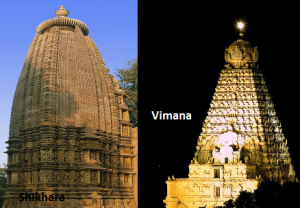
- Amalaka: Stone-like disc seen at the top of the temple. Mostly in north Indian temples.
- Kalasha: It is the topmost part of the temple. Mainly seen in north Indian styles.
- Antarala: It is a vestibule between the Garbhagriha and the Mandapa.
- Jagati: This is common in north Indian temples and is a raised platform where devotees can sit and pray.
- Vahana: It is the vehicle of the main deity which along with the standard pillar or Dhvaj which are placed axialy
Types of Indian Temple Architecture/Styles
Basically there are 3 kinds of temple architecture:
- Nagara Style
- Dravida Style
- Vesara Style
The Nagara or North Indian temple style
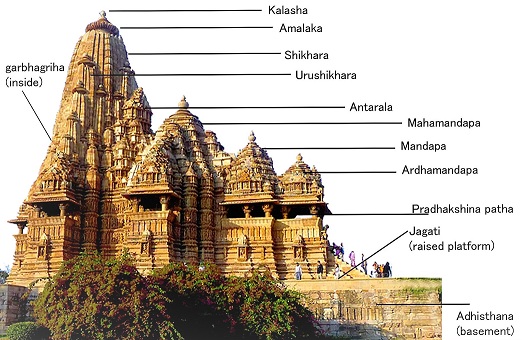
- Became popular in northern India.
- Entire temple is generally built on a stone platform with steps leading to it.
- No grand boundary walls or gateways (unlike the Dravida style).
- Earlier temples had one shikhara whereas latter temples had many.
- The garbhagriha is located directly beneath the tallest shikhara.
Subdivisions of Nagara Style
- Based on Style:-
-
Rekha-prasada/Latina:
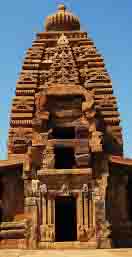
- Simple shikhara with square base and whose walls slope inwards to a point on top.
- Most common.
- In later periods, latina type became more complex with several towers clustered together.
- The tallest tower was at the centre and the garbhagriha was directly beneath it.
-
Phamsana:
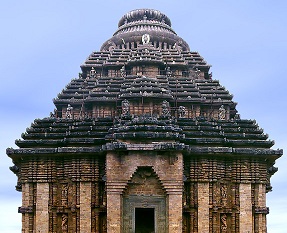
- Roofs composed of many slabs that gently rise to a single point over the building’s centre.
- Roofs do not curve inwards like the latina type, but they slope upwards on a straight incline.
- Phamsana structures are generally broader and shorter than latina ones.
- In many temples, the latina type is used to house the garbhagriha whereas the mandapa has a Phamsana style of architecture.
-
Valabhi:
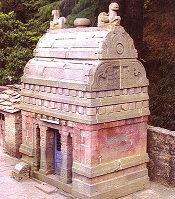
- Rectangular buildings with a roof that rises into a vaulted chamber.
- Also called wagon-vaulted buildings.
Nagara Style in Various Regions:-
Central India
- Uttar Pradesh, Madhya Pradesh, Rajasthan.
- Made of sandstone.
- Oldest surviving structural temples from the Gupta period are in MP. They are small shrines with four pillars to support a small mandapa. The mandapas are basically small porch-like structures before the garbhagriha which are also rather small. Examples: temple at Udaigiri – part of a larger Hindu complex of cave shrines (outskirts of Vidisha); temple at Sanchi (which was a Buddhist site).
- This shows how similar architectural developments were incorporated in both religions.
Dashavatara Vishnu Temple, Deogarh, UP
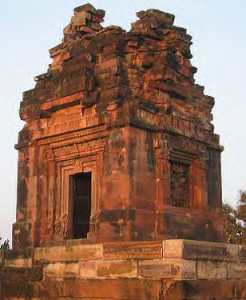
- Classic example of the late Gupta period temple architecture.
- Patrons are unknown.
- From the architecture and imagery, it is known that the temple was built in early 6th century CE.
- Panchayatana Style of architecture.
- Main shrine is built on a rectangular plinth with four subsidiary shrines that are smaller and at the 4 corners.
- Hence, there are a total of five shrines and hence the name, Panchayatana.
- This temple has a rekha-prasada type of shikhara.
- It is a west-facing temple. Most temples are north or east facing.
- Has a grand doorway with figures of Ganga and Yamuna on the left and right side respectively.
- Depicts Vishnu in various forms. 3 main Vishnu reliefs on the temple walls: Sheshashayana on the south; Nara-Narayan on the east; and Gajendramoksha on the west.
- Since it was assumed that the subsidiary shrines had avatars of Vishnu in them, the temple was mistaken to be Dashavatara temple.
Khajuraho Temples (MP)
- Built in the 10th century CE.
- It is a UNESCO World Heritage Site.
- Patronised by Chandela Kings.
- All temples made of sandstone.
- From the temple at Deogarh (built about 400 years before Khajuraho temples), the development of the Nagara architectural style is visible here.
- These temples are known for their extensive erotic sculptures. Mostly Hindu, though some Jain temples are also present.
- There are also temples dedicated to Yoginis which form part of Tantric worship indicating the rise and spread of tantric cult after the 7th century. E.g. Chausanth Yogini temple.
- Important temples in Khajuraho: Kandariya Mahadeo (dedicated to Lord Shiva) and Lakshmana temple.
- Lakshmana temple

- Grandest of the Khajuraho temples.
- Dedicated to Vishnu.
- Built by the Chandela King Dhanga in 954 CE.
- Structure is placed on a high platform that is accessed by stairs.
- Has small temples in four corners.
- Has high shikharas, amalak and kalash. Also has projecting balconies and verandas.
West India
- Gujarat, Rajasthan and western MP.
- Sandstone is most common, grey to black basalt is also seen in some 10 – 12th century temples.
- Also seen is soft white marble in 10 – 12th century Jain Temples at Mount Abu and a 15th century temple at Ranakpur.
- Samlaji in Gujarat is an important art historical site. Many sculptures made of grey schist are found here.
- Sun Temple, Modhera, Gujarat

- Built by Raja Bhimdev I of the Solanki dynasty in 1026 CE.
- Temple complex features a huge rectangular stepped tank known as the ‘Surya Kund’ in the front. This is a noticeable feature from earlier times – proximity of a sacred water body. By the early 11th century, this was a common feature of many temples.
- The Surya Kund is a 100 sq.m pond – one of the grandest of its kind in the country. 108 miniature shrines are carved in between the steps inside the tank.
- A large ornamental torana (gateway) leads to the sabha mandapa or assembly hall that is open on all sides.
- Lavish carving and sculpture work is present.
- The central shrine walls are plain. The temple is east-facing and every year at the time of equinoxes, the sun shines directly onto the central shrine.
Get important famous temples in India in the linked article.
Temple Architecture in India (UPSC Notes):- Download PDF Here
This chapter is continued in the link given below:
Also Read:
| NCERT Notes: Temple Architecture and Sculpture – Part II |
| Pallavas: Society and architecture |
| Facts about Indus Valley Civilization |
UPSC Books List PDF:-Download PDF Here
UPSC Preparation
| UPSC Prelims | UPSC Mains |
| UPSC Exam Pattern | IAS Exam |
| UPSC Books | Daily News Analysis |
| UPSC Previous Year Question Papers | IAS Current Affairs |
| NCERT Notes For UPSC | Daily Video Analysis: The Hindu |
Comments